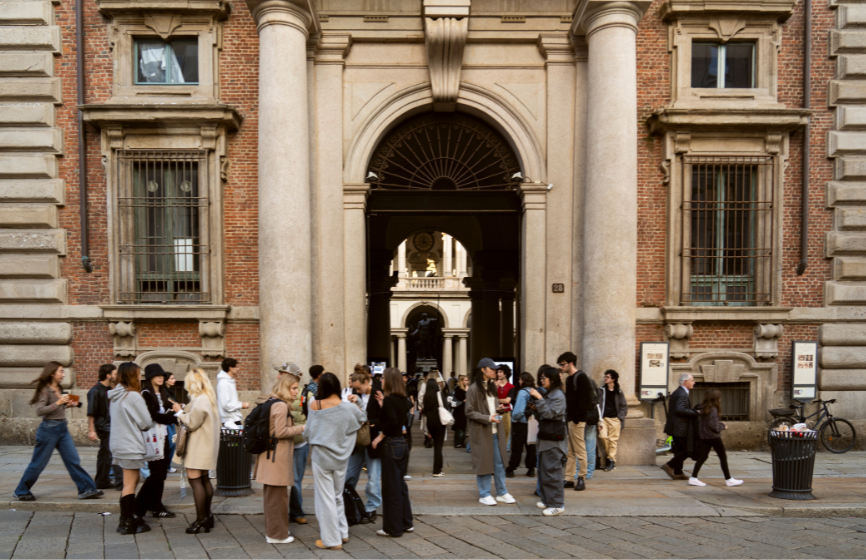Milano has seen the extraordinary contribution of many women who have left their indelible mark on the city’s history. Women who have inspired generations with their work and dedication, as described in the book “Le donne di Milano” by Angelo Monti. So every stop on this itinerary pays tribute to the extraordinary legacy of these women.
Similarly, each place is a piece in the rich tapestry of the socio-cultural history of a city that never ceases to amaze and inspire.
We begin our journey at the Fondazione Prada, a centre for culture and art that is of great importance for contemporary art, cinema, photography, philosophy and architecture.
Established in 1993 by Miuccia Prada and Patrizio Bertelli, the Foundation features an elaborate architectural layout that combines existing buildings and three new ones (Podium, Cinema and Tower); the result of the conversion of a distillery dating back to 1910, to a project designed by the OMA architecture firm, headed by Rem Koolhaas.
The life and work of Miuccia Prada are recounted in the book “Vita Prada” by Gian Luigi Paracchini.
Fondazione Prada is open every day from 10 a.m. to 7 p.m. except Tuesdays.
How to get there:
Metro: Lodi
Suburban line: Porta Romana
Overground public transport: 65, 90, 91, 92
Our second stop is Via Gesù, the heart of the Versace maison’s fashion world. Donatella Versace, the label’s creative director, has transformed the brand into a global icon. Its fashion shows, famous for being daring and spectacular, have been immortalised in the book “Versace. Sfilate”. This street is the creative hub and the headquarters of the brand, where every collection starts life. It is located in the heart of the “fashion quadrilateral”, the shopping and lifestyle mecca of the Montenapoleone District, the most deluxe area of the city where history, tradition, creativity and innovation come together.
How to get there:
Metro: San Babila, Montenapoleone
Overground public transport: 1, 85, 94
We head to the INAF - Brera Astronomical Observatory, a centre of excellence for astronomy. Founded in 1764, it is one of Europe’s oldest observatories and is a point of reference for scientific research to this day.
Margherita Hack, one of the most influential astronomers of the 20th century, often worked with the institute and her life and work are explored in more detail in her book “Siamo fatti di stelle”. The observatory is located in Milano’s most romantic quarter, and one of the city’s liveliest areas: the chic quarter of Brera, in the historic city centre.
How to get there:
Metro: Lanza
Overground public transport: 1, 2, 12, 14, 85
We are now in front of one of Milano’s most important buildings: the prestigious Teatro alla Scala opera house built in the 18th century to be one of the most majestic in the world. While its style is typically neo-classical, its real forte is its acoustics, not to mention its sumptuously decorated interiors.
Among the opera, classical music and ballet artists who have taken to the stage of this exclusive venue over its two centuries in existence, there are many world-famous names, including Carla Fracci: a “prima ballerina assoluta” (according to the New York Times), who needs no introduction.
Her autobiography “Passo dopo passo. La mia storia”, tells the story of her extraordinary life and her contribution to the world of dance, where she has “flown” in the world’s most important theatres.
How to get there:
Metro: Duomo. Montenapoleone
Overground public transport: 1, 2, 12, 14, 16, 19
Our fifth stop takes us to the Shoah Memorial at the Central Station. The Memorial is located in the area below the railway tracks where prisoners leaving the San Vittore prisons were loaded onto cattle wagons, like Liliana Segre, the Holocaust survivor who is now a life senator.
An iconic symbol of the resistance and for hope, her story is told in the book “La stella polare della Costituzione”. Today the Memorial is a multifunctional centre for meetings, debates and exhibitions remembering the past, and a place for different cultures to get together.
A similar place nearby is the Casa della Memoria, in the Isola neighborhood, a monument commemorating the fight against Nazism and Fascism, terrorism, and the massacres of the second half of the 20th century.
How to get there:
Metro: Centrale
Overground public transport: 1, 5, 10, 42, 87, 90, 91, 92
We end our itinerary at the Casa Museo Boschi di Stefano, a historic house museum celebrating the art and culture of Marieda Di Stefano: an artist and collector who left the city a huge cultural legacy. Located in an elegant palazzo in Via Giorgio Jan, the house museum features a collection of over three hundred 20th century pieces, including works by maestros like Boccioni, De Chirico and Fontana. The house, once home to Di Stefano and her husband Antonio Boschi, is now a museum open to the public from 10 a.m. to 5.30 p.m. except Tuesdays.
How to get there:
Metro: Lima
Overground public transport: 60, 81
Initiative created thanks to the resources of the Development and Cohesion Plan of the Italian Ministry of Tourism "Piano di Sviluppo e Coesione del Ministero del Turismo"

 Log in
Log in


